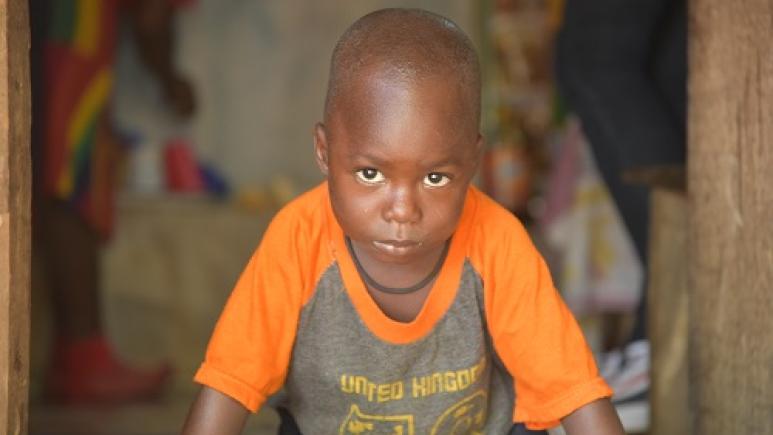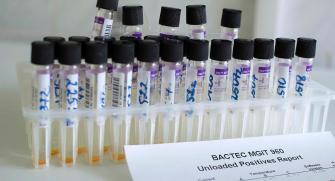Treatment decision algorithms, a hope for the diagnosis of tuberculosis in children.
The TACTiC project - Test, Avoid, Cure TB in Children - launched at the end of 2023 by Médecins Sans Frontières (MSF), plans to implement recommendations in 12 countries in Africa and Asia. These algorithms, although relatively simple and not requiring complex laboratory analyses, remain largely under-utilized and have not yet been evaluated. As part of TACTiC, Epicentre will coordinate operational research to evaluate their performance and acceptability.
According to WHO data, in 2022, 214,000 children and young adolescents (aged under 15) died because of tuberculosis, representing 16% of all tuberculosis deaths (1). Even more alarming, 96% of them had never been put on treatment (2).
The head of MSF's tuberculosis working group, Cathy Hewison, highlights the challenges of diagnosing tuberculosis in children: "The clinical presentation of tuberculosis is not very specific in children, and can resemble many other common illnesses. The disease can progress rapidly in at risk children, particularly those under 2 years of age, infected with HIV or malnourished, and the collection of sputum samples for respiratory diagnosis proves difficult in children. In addition, limited access to X-rays and molecular tests exacerbates the situation."
To date, there are no simple, reliable, inexpensive, and easily accessible diagnostic tests to detect tuberculosis in children. The diagnostic tools available are insufficient, and rarely integrated into primary health care, where most children with tuberculosis seek treatment. As a result, children are often diagnosed very late, and for those who are most at risk of developing the most severe forms of tuberculosis, these delays are often fatal. However, if children are diagnosed all anti-tuberculosis drugs approved for use in children are now available in pediatric formulations.
Treatment decision algorithms, a solution for decentralized diagnostics
Since 2022, the WHO has issued a provisional recommendation for the use of two integrated treatment decision algorithms (TDA): they enable early detection of tuberculosis in children under 10 with signs suggestive of pulmonary tuberculosis, and rapid initiation of treatment. A decision to start treatment is based on the allocation of a certain number of points according to symptoms (cough, fever, night sweats, etc.). One algorithm includes radiography, while the other is adapted to the context without radiography. Above a certain threshold score obtained by adding up the points, it is recommended to initiate an appropriate treatment against tuberculosis, which for patients with non-severe forms can be the newly recommended 4 months of treatment.
Three months of preventive treatment are also recommended for children who have been in contact with cases of tuberculosis.
"One of the great strengths of these algorithms lies in their ability to be deployed in contexts lacking specialized diagnostic tools, by non-specialized teams, and as close as possible to patients. Our initial experience has shown that the number of children diagnosed with tuberculosis can be increased by up to five times," explains Cathy Hewison.
Starting at the end of 2023, the TACTiC project aims to help MSF missions and teams - particularly those not specialized in tuberculosis care - to initiate the implementation of these WHO recommendations to increase the number of children diagnosed and therefore put on treatment rapidly. A total of 12 countries are expected to be involved.
Algorithm performance and acceptability
Helena Huerga, epidemiologist at Epicentre and coordinating principal investigator for the study, points out that these algorithms have never been evaluated in operational contexts, therefore data generation has been requested by WHO. In addition to their deployment, the TACTiC project therefore includes an operational research component piloted by Helena Huerga, comprising a multi-country diagnostic study to assess the performance of these algorithms and a mixed-methods study on their feasibility and acceptability. These studies are currently taking place in 5 countries with distinct pediatric care contexts:
- Maiduguri in Nigeria since August 2023,
- Madarounfa in Niger and Conakry in Guinea since September 2023,
- Malakal in South Sudan and Mbarara in Uganda since October 2023.
These sites document any difficulties encountered during program implementation, and their experience is used to propose transferable solutions to facilitate roll-out in other locations. A total of 2,000 children with suspected tuberculosis will be included in the study. All other sites are considered to have a high incidence of tuberculosis. Children are more vulnerable to TB if they are malnourished or living with HIV. Niger and Nigeria sites focus in children with severe malnutrition, in Guinea in children living with HIV, while Uganda and South Sudan focus on the general pediatric population.
In the run-up to the study, we had to train the teams, deal with a number of questions about the application of the algorithms and ensure that the supply of treatment from national tuberculosis programs would be sufficient.
Focus on Niger: little tuberculosis, but high prevalence of malnutrition
In Niger, the study is taking place at the Centre de Récupération et d'Éducation Nutritionnelle Intensifs (CRENI) at Madarounfa Hospital, equipped with X-ray, where the algorithms were implemented in June 2023 by MSF for all children in the pediatric program. The study also includes the Centre de Récupération Nutritionnelle Ambulatoire pour la Malnutrition Sévère (CRENAS) at the Dan Issa Integrated Health Center in Madarounfa, where radiography is not available. Niger is also one of three sites, along with Uganda and Guinea, where a qualitative survey will be carried out. The survey will take place in 3 phases - before, during and after the implementation of the algorithms - and is designed to assess the feasibility and acceptability of implementing TDA with healthcare staff and communities.
All children included undergo evaluation by the TDA, which includes a full clinical examination, laboratory tests (Xpert MTB/RIF) and a chest X-ray for those with severe acute malnutrition hospitalized at Madarounfa.
Helena Huerga explains: "The Xpert MTB/RIF test, an automated molecular diagnostic, is highly performant in adults but the difficulty is to obtain adequate samples from the children limits its use in the pediatric population. "
Each step in the cascade of the treatment decision algorithm will be thoroughly described, providing a detailed understanding of the diagnostic process. Evaluation of pediatric tuberculosis cases before and after implementation of the algorithms will enable to assess their impact on the cases diagnosed with TB. It will also be possible toto collect additional data on the added diagnostic value of the TB-LAM urine test in children with severe acute malnutrition, and to document the contribution of radiography in diagnosis.
As one health worker noted of the TDA: "We've had a hard time treating tuberculosis in children, but this time, since the arrival [of the TDA], I'm sure we'll have a large number of children under our care."
Changing the status quo in the face of TB
Subsequently, all the data collected in this phase will be used to develop tools that can be adapted to most MSF projects. The data will also support mobilization and advocacy with national health programs, ministries of health and other key stakeholders to accelerate the deployment of these tools.
With TACTiC, the aim is to change the game for children with tuberculosis by proposing a global approach, from team training to treatment initiation, adapted to different contexts and enabling decentralized detection of tuberculosis at the primary healthcare level.
-
https://www.who.int/fr/news-room/fact-sheets/detail/adolescents-health-risks-and-solutions
-
Dodd PJ, Yuen CM, Sismanidis C, Seddon JA, Jenkins HE. The global burden of tuberculosis mortality in children: a mathematical modelling study. Lancet Glob Health. 2017;5(9):e898-e906. doi:10.1016/ s2214-109x(17)30289-9.
© Nargiz Koshoibekova









